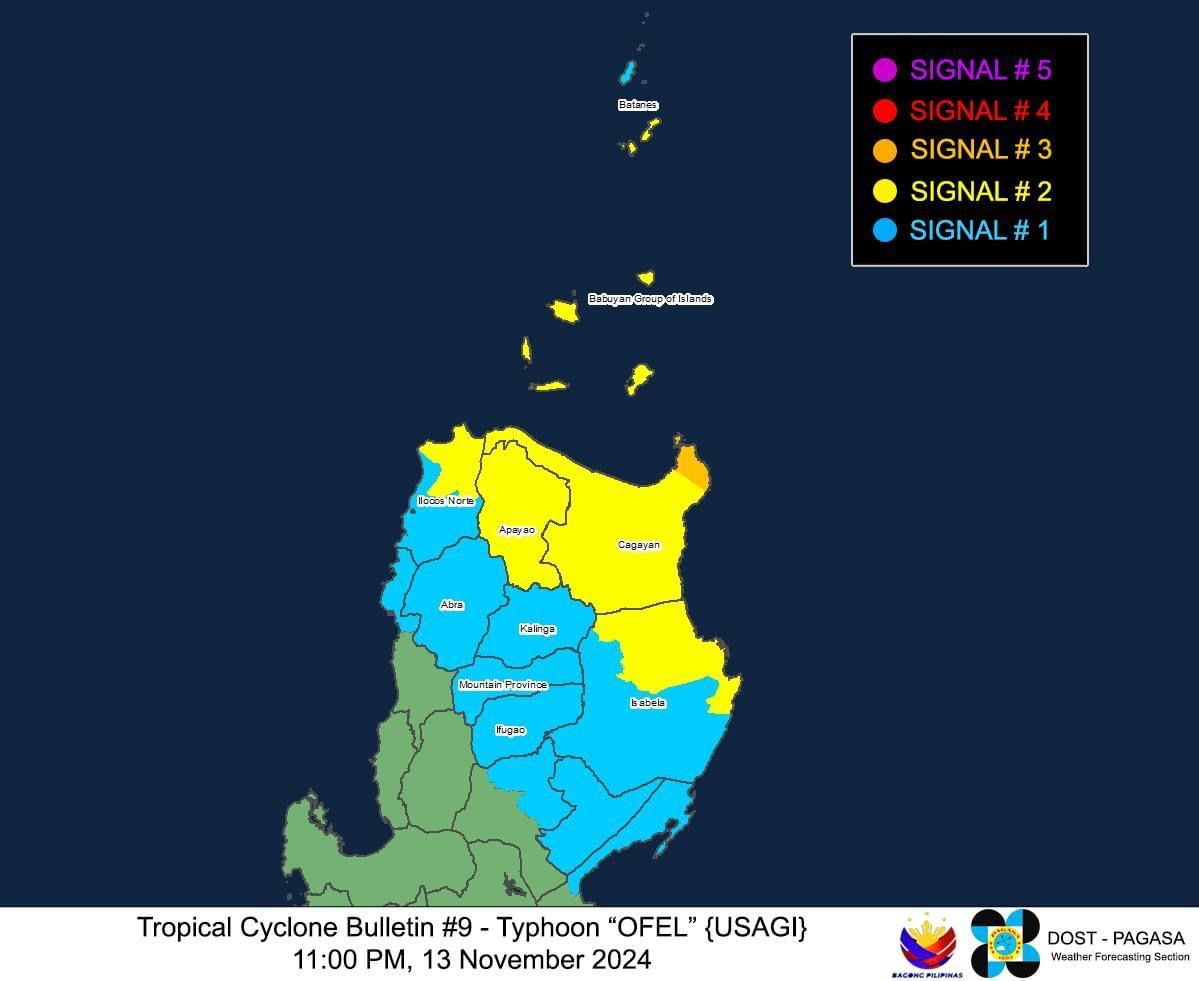Signal No. 3 up as Typhoon Ofel further intensifies; Signal No. 5 possible
At A Glance
- Typhoon Ofel is expected to reach the eastern coast of Luzon and may make landfall over Cagayan or Isabela by Thursday afternoon, Nov. 14.
- The highest wind signal that may be issued during the passage of the typhoon is Signal No. 4, although the possibility of raising Signal No. 5 has not been ruled out.
- Heavy to intense rains are expected to affect parts of Northern and Central Luzon.

The Philippine Atmospheric, Geophysical and Astronomical Services Administration (PAGASA) raised Wind Signal No. 3 over a portion of Cagayan province on Wednesday, Nov. 13, as Typhoon “Ofel” (international name: Usagi) continued to intensify over the Philippine Sea.
In its 11 p.m. bulletin, PAGASA said Ofel now has maximum sustained winds of 150 kilometers per hour (kph) near its center and gusts reaching 185 kph. Previously, it had maximum sustained winds of 130 kph and gusts of 160 kph.
The highest wind signal that may be issued during the passage of Typhoon Ofel is Signal No. 4, although the possibility of raising Signal No. 5 has not been ruled out.
As of Wednesday evening, PAGASA has raised Signal No. 3 over the northeastern portion of mainland Cagayan (Santa Ana).
Signal No. 2 remains in effect over the southern portion of Batanes (Mahatao, Uyugan, Basco, Ivana, Sabtang), The rest of Cagayan including Babuyan Islands, northern and eastern parts of Isabela (Maconacon, Divilacan, Palanan, San Pablo, Cabagan, Santa Maria, Santo Tomas, Tumauini, Ilagan City), Apayao, and northern portion of Ilocos Norte (Carasi, Vintar, Burgos, Adams, Pagudpud, Bangui, Dumalneg).
Signal No. 1 is also up over the rest of Batanes, the rest of Isabela, Quirino, northern portion of Nueva Vizcaya (Kasibu, Ambaguio, Solano, Bayombong, Quezon, Bagabag, Diadi, Villaverde), Kalinga, Abra, Mountain Province, Ifugao, the rest of Ilocos Norte, northern part of Ilocos Sur (Sinait, Cabugao, San Juan, San Ildefonso, Magsingal, Santo Domingo, Bantay, San Vicente, City of Vigan, Caoayan, Santa Catalina, Santa, Nagbukel, Narvacan), and northern Aurora (Dilasag, Casiguran, Dinalungan, Dipaculao).
PAGASA said “moderate to significant impacts” from gale-force winds are possible in areas under Signal No. 3.
Meanwhile, areas under Signal No. 2 may experience “minor to moderate impacts” from strong winds, while those under Signal No. 1 may face “minimal to minor impacts.”
Landfall
As of 10 p.m., the center of Ofel was located 295 kilometers east of Casiguran, Aurora and is moving west-northwestward at 25 kph.
The typhoon is expected to reach the eastern coast of Luzon and may make landfall over Cagayan or Isabela by Thursday afternoon, Nov. 14.
PAGASA warned that Ofel could make landfall at its peak intensity.
After landfall, Ofel may move over the Babuyan and Balintang Channels on Friday, Nov. 15, pass close to or make landfall over Babuyan Islands, and turn northeast towards the sea east of Taiwan on Saturday, Nov. 16.
PAGASA pointed out that, regardless of the exact landfall location, hazards are not limited to the landfall area but will also affect areas affected by the typhoon’s outer cloud bands.
It added that Ofel’s track could still change as it moves closer to the country.
Rainfall outlook
PAGASA said intense to torrential rainfall (over 200 millimeters) may affect Cagayan and Isabela in the next 24 hours.
Heavy to intense rains (100 to 200 millimeters) could also affect Apayao and Kalinga, while moderate to heavy rainfall (50 to 100 millimeters) may prevail over Batanes, Ilocos Norte, Abra, Mountain Province, Ifugao, Quirino, Nueva Vizcaya, and Aurora.
The weather bureau warned that these conditions could lead to flooding and landslides, particularly in areas highly susceptible to such hazards and those with significant previous rainfall.